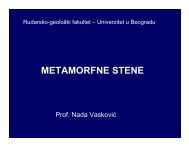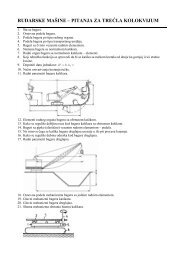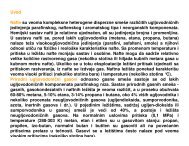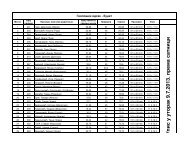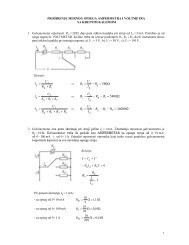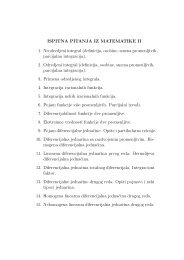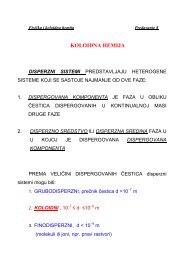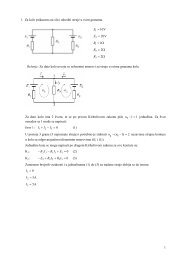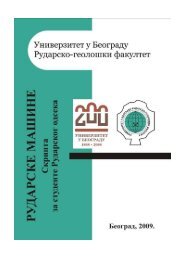KÑига LXXII
KÑига LXXII
KÑига LXXII
Create successful ePaper yourself
Turn your PDF publications into a flip-book with our unique Google optimized e-Paper software.
Late Cretaceous marine biodiversity dynamics in the Eastern Caucasus, northern Neo-Tethys Ocean 35<br />
might have been linked to the OAE3 event recognized<br />
in some other regions (ARTHUR & SCHLANGER 1979;<br />
JENKYNS 1980; ARTHUR et al. 1990; JENKYNS et al.<br />
1994; REY et al. 2004; WAGNER et al. 2004;<br />
TAKASHIMA et al. 2006; JONES et al. 2007) and left<br />
some imprint on marine organisms (e.g., PREMOLI<br />
SILVA & SLITER 1999, TOSHIMITSU & HIRANO 2000;<br />
TAKAHASHI 2005). But both, duration and global<br />
extent of the OAE3 itself remain questionable, which<br />
precludes us from drawing any definite conclusion<br />
about its signature in the Eastern Caucasus. Similarly,<br />
we are not aware of any supporting evidence (either<br />
geochemical or lithological) of significant oxygen<br />
depletion at the Coniacian-Santonian transition in the<br />
study area. On the other hand, if the OAE3 was a<br />
global event affecting the marine biota, the biodiversity<br />
loss in the Eastern Caucasus was quite likely<br />
related to this event. Furthermore, the presence of the<br />
Coniacian/Santonian disruption in the marine ecosystems<br />
in the Eastern Caucasus region could be interpreted<br />
towards a broader extent of the OAE3 event.<br />
However, all above-said is valid only, if the early<br />
Santonian-late Campanian biotic crisis was a true<br />
event. If it was just apparent (see above), none regional<br />
evidence of the OAE3 should be hypothesized.<br />
Considering the regionally-reported late Maastrichtian<br />
biodiversity minimum, it should be noted that<br />
KELLER (2008) suggested the diversity of marine<br />
species reached its maximum during the mid-Maastrichtian<br />
to be followed by stress started ~ 400 kyr<br />
before the end of the Cretaceous. If so, the reduction<br />
in macroinvertebrate diversity during the late Maastrichtian<br />
(Fig. 2) in fact can be an only regional phenomenon<br />
traced in the Eastern Caucasus.<br />
One may hypothesize that the observed biodiversity<br />
dynamics, both regional and global, is influenced<br />
by the chosen stratigraphic scale. In other words, the<br />
stages with longer time duration may exhibit an<br />
apparent higher diversity. A comparison of the<br />
absolute length of stages with changes in diversity<br />
(Fig. 4) does not indicate any dependence. The<br />
regional diversity peak occurred in the stage with the<br />
shortest duration (Coniacian), whereas the global<br />
diversity also peaked in the relatively short stages<br />
(e.g., Maastrichtian). Thus, the chosen stratigraphic<br />
scale seems not to have a biasing affect on the biodiversity<br />
results here.<br />
The documented diversity minima may be interpreted<br />
as the true expressions of regional biotic crises.<br />
However, it needs to be considered that every set of<br />
regional palaeontological data is incomplete because<br />
of interruptions of the fossil record (so-called ‘Lazarus<br />
effect’ - see RUBAN & VAN LOON 2008). Temporal<br />
disappearance of genera because of migrations,<br />
changes in the preservation state, etc. might have<br />
caused those total diversity minima mentioned above.<br />
Our data (Appendix 1) indicate that ranges of only<br />
two genera were temporally interrupted at the time of<br />
the late Cenomanian-late Turonian diversity minimum,<br />
whereas 6 interruptions were found at a time of<br />
the early Santonian-late Campanian diversity minimum.<br />
In both cases, however, this incompleteness is<br />
not so significant to postulate the minima were just<br />
apparent because of pseudoextinctions. We can just<br />
point out that the early Santonian-late Campanian<br />
biotic crisis was more affected by the state of the<br />
regional fossil record than that during the late<br />
Cenomanian-late Turonian.<br />
Fig. 4. Dynamics of the Late Cretaceous global (after<br />
PURDY 2008) and regional (Azerbaijan, this study) marine<br />
biodiversity calculated per stage. See Fig. 2 for stage<br />
abbreviations. Numbers given below the stage abbreviations<br />
on the horizontal axis indicate the absolute duration<br />
(in Ma) of the stages (calculated on the basis of OGG et al.<br />
2008).<br />
Possible factors of biodiversity dynamics<br />
Our results raise the question about the factors,<br />
which drove the diversity of marine macroinvertebrates<br />
in the Eastern Caucasus throughout the Late<br />
Cretaceous and triggered the documented biotic<br />
events. We consider oceanic anoxia, seawater palaeotemperature<br />
changes and shoreline shifts as possible<br />
environmental controls on biodiversity dynamics. Regional<br />
patterns, which coincide with global ones, may<br />
be explained by the possible influence of global<br />
mechanisms like oceanic anoxia. This does not mean,<br />
however, that only global influences were a driving<br />
force. In contrast, they interacted with regional factors<br />
such as seawater palaeotemperature changes and<br />
shoreline shifts.<br />
Although detailed geochemical studies of the<br />
Cenomanian-Turonian transition in Azerbaijan still<br />
need to be done, black shales, which bear an evidence<br />
of synsedimentary oxygen depletion, are locally<br />
reported from this transition (e.g., ALI-ZADEH 1988).<br />
Additionally, black organic-rich laminated marlstones



